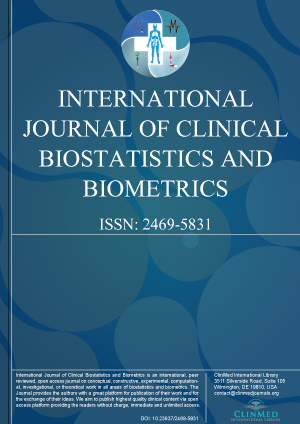Early Online
Open Access DOI:10.23937/2469-5831/1510058
Alexandra R Brown, Byron J Gajewski, Matthew S Mayo, Edward F Ellerbeck and Christie A Befort
Article Type: Original Article | Indexed Archive: Volume 11
Article Formats
- Full Article
- XML
- EPub Reader
Open Access DOI:10.23937/2469-5831/1510056
IFST2BR: An Interpretive Framework for Statistical Tests Aimed at Budding Biological Researchers
Shahad Dakhil Khalaf
Article Type: Research Article | Indexed Archive: Volume 10
Article Formats
- Full Article
- XML
- EPub Reader
Open Access DOI:10.23937/2469-5831/1510055
A Comparative Study of Probability Distribution Models for Number of Antenatal Visits
Ayodeji Isaac Akinjisola and Emmanuel Teju Jolayemi
Article Type: Original Research | Indexed Archive: Volume 10
Article Formats
- Full Article
- XML
- EPub Reader
Open Access DOI:10.23937/2469-5831/1510054
Design of Inequality Models of Covid-19 Disease Incorporating Social Discriminants
Yisa Oluwatoyin Anthonio, Joseph Adekunle Akinyemi and Kamilu Rauf
Article Type: Original Article | Indexed Archive: Volume 10
Article Formats
- Full Article
- XML
- EPub Reader
Open Access DOI:10.23937/2469-5831/1510053
Calvin Guan, Rhoda Au, Alvin Ang and Ashis Gangopadhyay
Article Type: Original Research | Indexed Archive: Volume 10
Article Formats
- Full Article
- XML
- EPub Reader
Open Access DOI:10.23937/2469-5831/1510051
Biostatistical Methodologies in Clinical Trials: An Overview of Recent Developments and Pitfalls
Sagar Kumar Patel, Rachna Patel and Sandeep Bolla
Article Type: Review Article | Indexed Archive: Volume 9
Article Formats
- Full Article
- XML
- EPub Reader
Open Access DOI:10.23937/2469-5831/1510050
Nkemnole EB and Kuti OO
Article Type: Research Article | Indexed Archive: Volume 9
Article Formats
- Full Article
- XML
- EPub Reader
Open Access DOI:10.23937/2469-5831/1510049
Hypothyroidism: A Small Clinical Trial Will Quickly Resolve the Combination Therapy Controversy
Timothy A Welborn, AO, PhD, FRCP, FRACP, MBBS and Satvinder S Dhaliwal, PhD, MSc, BSC
Article Type: Letter | Indexed Archive: Volume 8
Article Formats
- Full Article
- XML
- EPub Reader
Open Access DOI:10.23937/2469-5831/1510048
A New Modified Liu Ridge-Type Estimator for the Linear Regression Model: Simulation and Application
Olasunkanmi J Oladapo, Abiola T Owolabi, Janet I Idowu and Kayode Ayinde
Article Type: Original Research | Indexed Archive: Volume 8
Article Formats
- Full Article
Open Access DOI:10.23937/2469-5831/1510047
Song Ying Chong, MBBS, Mahmoud Danaee, PhD and Dharmendra Ganesan, FRCS
Article Type: Original Article | Indexed Archive: Volume 8
Article Formats
- Full Article
Open Access DOI:10.23937/2469-5831/1510046
Time Based Prediction of Breast Cancer Tumor Recurrence Using Machine Learning
Siddharth Raj Gupta
Article Type: Original Article | Indexed Archive: Volume 8
Article Formats
- Full Article
- XML
- EPub Reader
Open Access DOI:10.23937/2469-5831/1510045
Triple Negative Breast Cancer Prevalence in Indian Patients over a Decade: A Systematic Review
Suvobrata Sarkar and Murtaza Akhtar
Article Type: Systematic Review and Meta-analysis | Indexed Archive: Volume 8
Article Formats
- Full Article
- XML
- EPub Reader
Open Access DOI:10.23937/2469-5831/1510044
Tian Qiu, Zhi Ma, Yong Zhao, Wenling Wang, Huimin Jiang, Fengdi Wang, Yuelu Chen, Ting-Li Han, Yang Yang and Lianlian Wang
Article Type: Original Research | Indexed Archive: Volume 8
Article Formats
- Full Article
- XML
- EPub Reader

Volume 8
Issue 1
Issue 1
